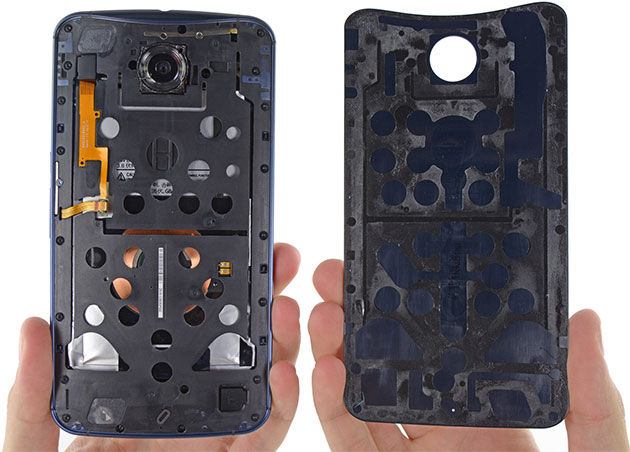Getting Screwed: Nexus 6 Teardown Uncovers 22 Screws Holding Mid-Frame Together
We've said it a thousand times before, but to make it a thousand and one, the big trend in mobile design these days appears to be adhesive, and lots of it. Whether it's a smartphone or tablet device, manufacturers seem obsessed with lathering the chassis with glue to seal the front and back panels together. Breaking the trend, Motorola opted for a fistful of screws when designing the Nexus 6 handset for Google.
That's not to say there isn't any glue, it's just not as prominent as on other devices. The folks at iFixIt described the use of adhesive securing the cover as "relatively mild," which made it easy for the team to pry and peel open the Nexus 6 with a pick.

However, that's only part one. Part two consists of removing tiny T3 Torx screws -- all 22 of them! Talk about a job in tediousness, though if you're not a fan of adhesive, this is the price you have to pay for an alternative method, at least as far as Motorola is concerned.
It's not a bad tradeoff. Once all the screws are taken out, the Nexus 6 "practically falls apart into two halves," with one half consisting of the midframe and battery assembly, and the other being the display and motherboard assembly.
One thing that's interesting to see inside the Nexus 6 is a copper inductive charging coil. Through a bit of technical wizardry, the inductive charging coil is the key to fast charging in the Nexus 6.

When the dust settled, the Nexus 6 ended up with a 7 out of 10 Repairability score. It earned brownie points for its modular parts, limiting the screws to a single type, and limited use of adhesive. On the negative side, several components are soldered directly to the motherboard, and the digitizer is fused to the display.
That's not to say there isn't any glue, it's just not as prominent as on other devices. The folks at iFixIt described the use of adhesive securing the cover as "relatively mild," which made it easy for the team to pry and peel open the Nexus 6 with a pick.

However, that's only part one. Part two consists of removing tiny T3 Torx screws -- all 22 of them! Talk about a job in tediousness, though if you're not a fan of adhesive, this is the price you have to pay for an alternative method, at least as far as Motorola is concerned.
It's not a bad tradeoff. Once all the screws are taken out, the Nexus 6 "practically falls apart into two halves," with one half consisting of the midframe and battery assembly, and the other being the display and motherboard assembly.
One thing that's interesting to see inside the Nexus 6 is a copper inductive charging coil. Through a bit of technical wizardry, the inductive charging coil is the key to fast charging in the Nexus 6.

When the dust settled, the Nexus 6 ended up with a 7 out of 10 Repairability score. It earned brownie points for its modular parts, limiting the screws to a single type, and limited use of adhesive. On the negative side, several components are soldered directly to the motherboard, and the digitizer is fused to the display.

